Table of Contents
Computer Vision and Deep Learning for Logistics
In today’s competitive market, having an efficient and flexible supply chain is a significant asset. Hence, companies are looking into ways to optimize their supply chain to help them make decisions to improve their operational efficiency and customer satisfaction and reduce environmental impacts.
According to McKinsey reports (Figure 1), AI will define a new “logistics paradigm” by 2030. It will generate $1.3-$2 trillion per year for the next 20 years as it continues to outperform humans at repetitive but mission-critical tasks. In another similar research, McKinsey has reported that businesses, by using AI, can improve their logistics, inventory, and service costs by 15%, 35%, and 65%, respectively.

This series is about CV and DL for Industrial and Big Business Applications. This blog will cover the benefits, applications, challenges, and tradeoffs of using deep learning in logistics.
This lesson is the 3rd of the 5-lesson course: CV and DL for Industrial and Big Business Applications 102.
- Computer Vision and Deep Learning for Oil and Gas
- Computer Vision and Deep Learning for Transportation
- Computer Vision and Deep Learning for Logistics (this tutorial)
- Computer Vision and Deep Learning for Healthcare
- Computer Vision and Deep Learning for Education
To learn about Computer Vision and Deep Learning for Logistics, just keep reading.
Computer Vision and Deep Learning for Logistics
Benefits
Enriching Data Quality
Machine learning and natural language processing can feed on vast volumes of information that pours into logistic companies daily. They can understand terms and phrases, draw connections to create a context that will enable optimal data usage within shipping, avoid risk, create better solutions, maximize resources, and slash costs. This enriched data can help the logistic company understand the precise amount of workforce and assets needed and help them make refinements in their day-to-day operations.
Strategic Asset Positioning
In 2021, it cost more than $20,000 to ship a standard 40-foot container from China to the U.S. East Coast. AI algorithms can help planners and logistic companies safely position and safeguard their assets. These algorithms can improve the utilization of predictive capacity matching by decreasing the shipment of empty containers and mitigating the number of vehicles on the road. By reducing and redirecting vehicles needed for transport to the locations where the demand is high, efficiency and cost reductions in asset position can be guaranteed.
Improved Predictive Analytics
Calculating the optimal transport of a single shipment from point A to point B needs sorting through data analytics, capacity estimation, and network analysis. It is nearly impossible for a human brain to perform these operations as they are time-intensive and error-prone. This is where the predictive power of AI comes into play. AI can easily compile accurate data, combine it with external factors and perform all these logistic procedures to estimate the upcoming demand. This can help the logistics company get a competitive edge in the transportation industry and cut unnecessary costs.
For example, International transport leader DHL uses a platform to monitor online and social media posts to identify potential supply chain problems. Their AI system can identify shortages, access issues, supplier status, etc.
Figure 2 shows the benefits of AI at every step of the supply chain.
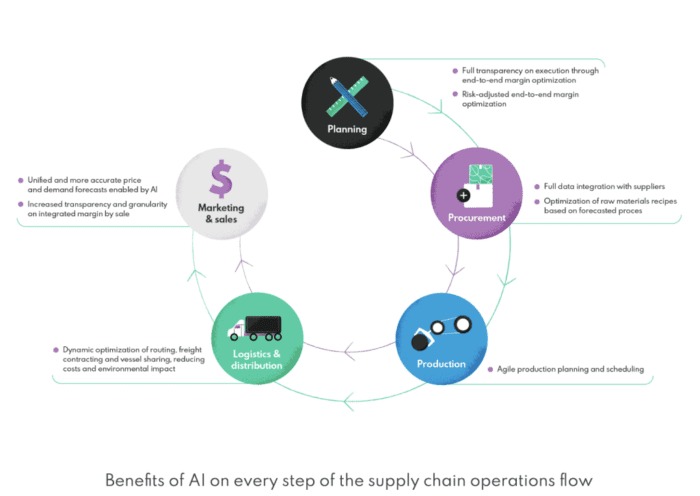
Applications
Forecasting and Planning
AI-enabled demand forecasting methods are more accurate than traditional forecasting approaches like ARIMA (AutoRegressive Integrated Moving Average) and exponential smoothing. These approaches consider demographic, weather, historical sales, current trends, and online and social media posts. Improved demand forecasting performance helps manufacturers reduce operational costs by reducing the number of vehicles dispatched, thus increasing asset utilization.
Typically there are two types of demand forecasting models: medium- to long-range forecasts and short-term forecasts. Companies usually use medium- to long-range estimates for budgeting and planning purchases of new assets (e.g., warehouses, vehicles, distribution centers, etc.). The range of these forecasts can lie anywhere between 1-3 years.
But most widely used forecasts in the industry are short-term, which highly influences operational planning and improves the bottom line for companies with low-profit margins. They typically range from a few days to a few weeks. For example, a forecast can predict the demand/sales of vehicles two weeks ahead with over 98% accuracy and six weeks ahead with 95% accuracy (Figure 3).
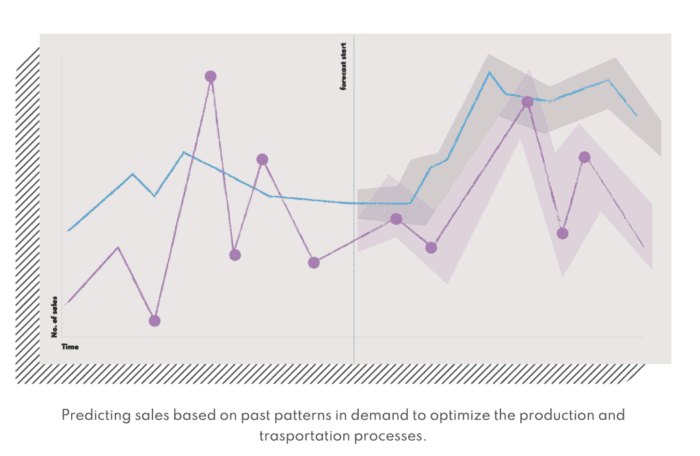
With the help of a demand forecast, companies can ensure the right amount of materials on hand and plan their production activities. The results can be combined with other relevant data about costs, capacities, etc. Moreover, suppose anything goes wrong during the supply chain management process (e.g., customers deciding not to place an order). In that case, predictive solutions can avoid the overproduction of products no one wants by identifying potential problems before they occur and adjusting accordingly.
To derive a forecast for the coming week’s purchases, OTTO has developed a deep learning algorithm that has analyzed three billion data records and 200 variables, including transactions, search queries on the OTTO website, and weather forecasts. As a result, the system made predictions with 90% accuracy of what will be sold within the next 30 days. This helped OTTO to order around 200,000 items in advance each month and to send items more quickly in a single consignment when a customer places an order.
Optimization
Route Optimization: Route optimization rationalizes the cost of last-mile delivery, a significant overhead to the logistics industry. AI can analyze historical trips, existing routes, and geographical, environmental, and traffic data to use shortest-path graph algorithms and identify the most efficient way for logistics trucks (Figure 4). This will reduce the shipping costs and carbon footprint.
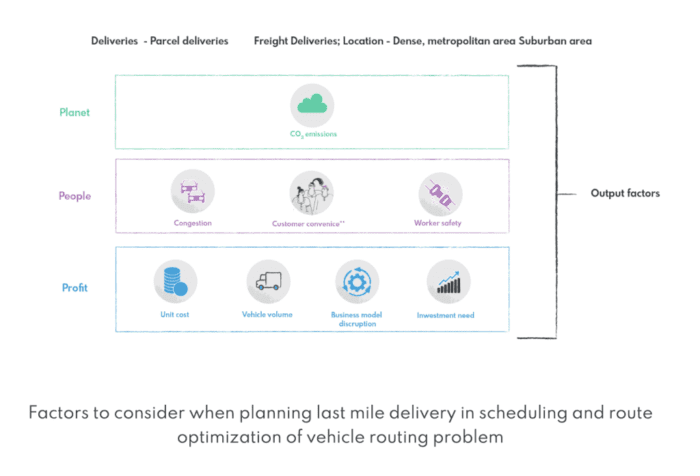
Zalando has trained a neural network called OCaPi algorithm (optimal cart pick) that can allow the picking work between the employees more effectively and accelerate the picking process. The algorithm considers not only the employees’ routes but also the paths of the carousel carriers, which are sometimes parked in transverse aisles while the employees collect items from the racks. In doing so, it comes up with the shortest route.
Cost and Price Optimization: Depending on demand and supply, prices of goods fluctuate. Based on past historical data about sales, volume, market conditions, currency exchange rates, and inflation, predictive analytics can help companies minimize the risk of pricing the item wrongly. These models can tell companies whether they should discount their prices or increase their margins, helping them stand out in the market (Figure 5).
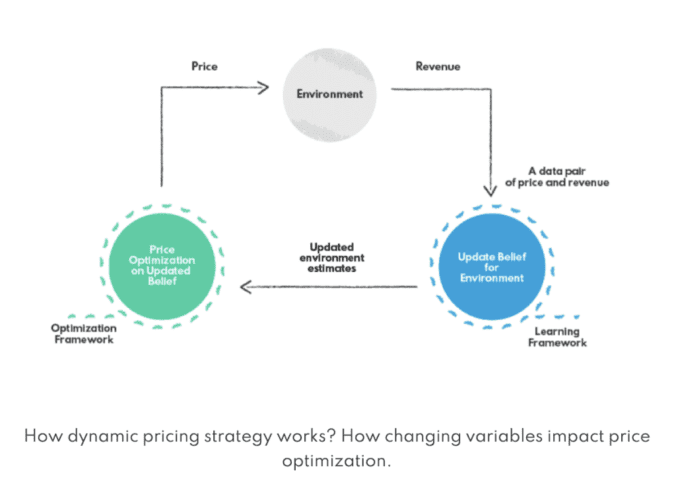
Inventory Optimization: Inventory optimization helps companies make the most of their supply chain. Too much inventory but no sales can lead to depreciation and losses — especially perishable goods such as food, medicines, etc. Predictive models can help organizations maintain the right level of supplies all the time, thus lowering their investment costs and wastage due to overproduction or understocking. In addition, these models can use historical data about customer behavior and upcoming events like holidays to make predictions.
Automated Warehouse
Automated warehousing (Figure 6) can be of two types: devices that help move goods and appliances that improve their handling. Automated Guided Vehicles (AGVs) can enable the movement of cases and pallets in the first type. They can be equipped with software to retrofit standard forklifts and make them autonomous. Other new technologies like swarm robots (e.g., Amazon’s Kiva robots) can help move shelves with goods to destination and conveyor belts. In addition, advanced automated storage/retrieval systems can store goods in large racks and have robotic shuttles that can move in three dimensions using the rails attached to the structure.

For example, the retail giant Amazon acquired Kiva Systems in 2012 and changed its name to Amazon Robotics in 2015. Today, Amazon has 200,000 robots working in their warehouses. In 26 of Amazon’s 175 fulfillment centers, robots help pick, sort, transport, and stow packages.
Handling devices can automate the picking, sorting, and palletizing of goods. They usually have sensors that can determine the shape and structure of the object. Then, using similar AI algorithms, these devices can filter out any bad things (e.g., Magazino’s new TORU cube). Even conveyor belts can be advanced by using AI automated sensors that can scan barcodes on any side of the package and determine the appropriate action.
Beyond these robotic machines, various other innovations can also improve the productivity of people in warehouses.
- Exoskeletons can augment human motion with mechanical power through gloves or additional support for the legs. The systems allow a person to move more goods (e.g., heavier items) or move goods more efficiently and safely.
- AI can automate the classification and identification of goods stored in the inventory using computer vision by accounting information (e.g., product dimensions, weight, etc.). AI can quickly locate these items in the warehouse without human assistance.
- If AI robots are in charge of operating hazardous equipment and storing inventory, employee safety will improve. Computer vision algorithms can track employees working, monitor various safety issues, and recognize any suspicious acts.
Predictive Maintenance
Predictive maintenance (Figure 7) involves detecting factory machine failures by analyzing real-time sensor data. For predictive maintenance to work correctly, all parameters associated with the movement of components must be recorded by sensors. For example, these factors include opening and closing events, control system actions, pressure cylinder, and roller wear for a dock.
The next step is prescriptive maintenance (Figure 7) which involves proactively scheduling maintenance for an off-peak period based on a prediction of the next malfunction, service date and time, spare parts to be supplied, etc. This plan may go so far as to influence the parameters for the equipment in question so that movements that could worsen the damage are no longer executed with full power. Rather as carefully as possible with optimal use of the infrastructure in order not to trigger a malfunction before the scheduled maintenance date.
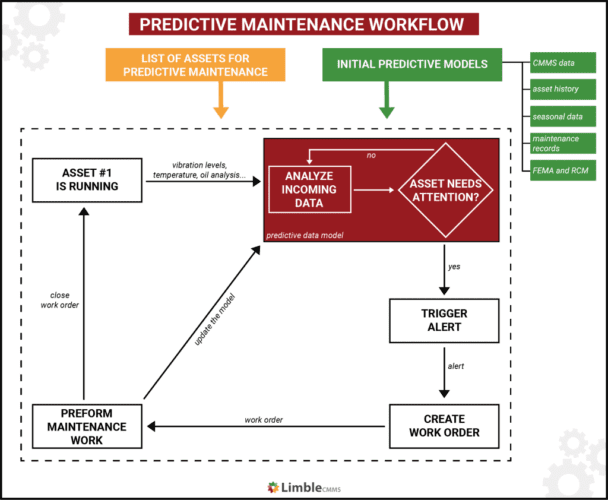
Moreover, it would be incorrect to assume that it is a case of solely relying on the sensors. Modern sensors and the linking of sensors make it possible to detect incorrect sensor values and for the AI to interpolate these in combination with other measurement values. However, the problem is not always the machine. The sensor itself may have a fault that does not necessarily have to lead to scheduled downtime.
By the way, you might find our computer vision hard topic finder useful if you need more background information.
Back-Office and Customer Experience
Back-Office Operations: Every business has back-office tasks that are done manually. Automated AI solutions can be applied to such tasks to increase back-office operational efficiency in the following ways:
- Automating Document Processing: Document automation technologies can be used for the fast processing of invoice/bill of lading/rate sheet documents by automating data input, error reconciliation, and document processing (Figure 8).
- Scheduling and Tracking: AI systems can schedule transportation, organize pipelines for cargo, assign and manage various employees to particular stations, and track packages in the warehouse.
- Report Generation: Robotic process automation (RPA) tools can auto-generate regular reports, analyze their contents and inform stakeholders and employees.
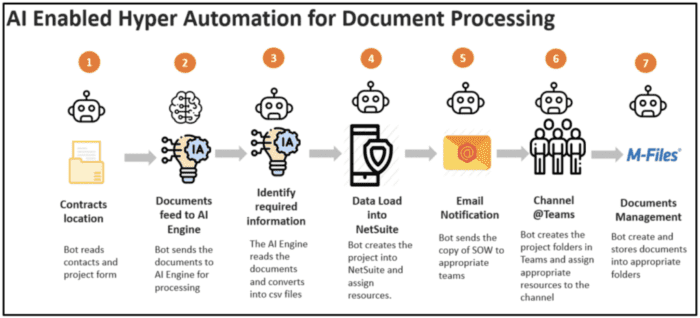
Customer Experience: Predictive solutions can help improve the customer experience by gaining insights into their behavior. They can identify what customers will likely purchase next, when they may cancel or return the product, the latest trends about buying personas, etc. Such a strategy helps a company retain its customers and, at the same time, attract new ones. These predictive algorithms can also segment customers based on their choices and behavior, enabling companies to adjust the supply chain and product prices earlier depending on demand.
The sales and marketing team can effectively target specific groups of customers based on their product. Managers can then understand how their marketing strategies impact customer buying decisions (e.g., why some people stopped using their product). What made them switch to other brands? Predictive analysis can also analyze social media posts such as mentions on Twitter, Facebook, and other products to get feedback from consumers without delay and improve their service.
Challenges
Applying AI in the logistics industry has its own risks and challenges.
Limited Access to Historical Data
For these predictive AI solutions to work effectively, companies must access large amounts of historical, high-quality data collected across various business units and supply chains. The quality and volume depend on the size of the company, its geographical location, and already employed IT solutions. Thus businesses need to invest resources and time to set up solutions and devices that can strategically collect relevant information about their business. A good piece of advice will be to start with low-investment AI Design Sprint workshops to approach data collection and predictive modeling implementation.
Lack of 360° Vision
Businesses still rely on legacy solutions that lack integration with other systems in the entire supply chain network. Software solutions typically don’t cover all the processes and are incompatible with different vendors, making it harder to merge data across platforms. This lack of a 360-degree view of the supply chain is the biggest challenge in employing predictive analytics.
Lack of AI-Skilled Professionals
Industries need to hire top-notch data scientists and machine learning experts to build and design their algorithms and systems. Unfortunately, the demand for such experts outweighs the supply, making it difficult for businesses to find and hire analytics professionals with solid expertise in business domain knowledge, data science, mathematics, and statistics. As a result, many companies fail to implement predictive analytics solutions because they do not have enough qualified employees to carry out complex AI projects.
What's next? We recommend PyImageSearch University.
86+ total classes • 115+ hours hours of on-demand code walkthrough videos • Last updated: December 2025
★★★★★ 4.84 (128 Ratings) • 16,000+ Students Enrolled
I strongly believe that if you had the right teacher you could master computer vision and deep learning.
Do you think learning computer vision and deep learning has to be time-consuming, overwhelming, and complicated? Or has to involve complex mathematics and equations? Or requires a degree in computer science?
That’s not the case.
All you need to master computer vision and deep learning is for someone to explain things to you in simple, intuitive terms. And that’s exactly what I do. My mission is to change education and how complex Artificial Intelligence topics are taught.
If you're serious about learning computer vision, your next stop should be PyImageSearch University, the most comprehensive computer vision, deep learning, and OpenCV course online today. Here you’ll learn how to successfully and confidently apply computer vision to your work, research, and projects. Join me in computer vision mastery.
Inside PyImageSearch University you'll find:
- ✓ 86+ courses on essential computer vision, deep learning, and OpenCV topics
- ✓ 86 Certificates of Completion
- ✓ 115+ hours hours of on-demand video
- ✓ Brand new courses released regularly, ensuring you can keep up with state-of-the-art techniques
- ✓ Pre-configured Jupyter Notebooks in Google Colab
- ✓ Run all code examples in your web browser — works on Windows, macOS, and Linux (no dev environment configuration required!)
- ✓ Access to centralized code repos for all 540+ tutorials on PyImageSearch
- ✓ Easy one-click downloads for code, datasets, pre-trained models, etc.
- ✓ Access on mobile, laptop, desktop, etc.
Summary
Companies are looking into ways to optimize their supply chain to help them make decisions to improve their operational efficiency and customer satisfaction and reduce environmental impacts. AI is defining a new “logistics paradigm” by serving various tasks in the logistics industry:
- Forecasting and Planning: With the help of a demand forecast, companies can ensure the right amount of materials on hand and plan their production activities. The results can be combined with other relevant data about costs, capacities, etc.
- Optimization: AI can analyze historical trips, existing routes, and geographical, environmental, and traffic data to use shortest-path graph algorithms and identify the most efficient way for logistics trucks. Further, based on past historical data about sales, volume, market conditions, currency exchange rates, and inflation, predictive analytics can help companies minimize the risk of pricing the item wrongly.
- Automated Warehouse: Automated Guided Vehicles (AGVs) can enable the movement of cases and pallets. They can be equipped with software to retrofit standard forklifts and make them autonomous.
- Predictive and Prescriptive Maintenance: It involves detecting factory machine failures by analyzing real-time sensor data and proactively scheduling maintenance for an off-peak period based on a prediction of the next malfunction, service date and time, spare parts to be supplied, etc.
- Back-Office Operations: Document automation technologies can be used for the fast processing of invoice/bill of lading/rate sheet documents by automating data input, error reconciliation, and document processing.
However, AI in the logistics industry comes with its challenges.
- Limited Access to Historical Data: For these predictive AI solutions to work effectively, companies must access large amounts of historical, high-quality data collected across various business units and supply chains. The quality and volume depend on the size of the company, its geographical location, and already employed IT solutions.
- Lack of 360° Vision: Businesses still rely on legacy solutions that lack integration with other systems in the entire supply chain network. Software solutions typically don’t cover all the processes and are incompatible with different vendors, making it harder to merge data across platforms.
- Lack of AI-Skilled Professionals: Industries need to hire top-notch data scientists and machine learning experts to build and design their algorithms and systems. Unfortunately, the demand for such experts outweighs the supply, making it difficult for businesses to find and hire analytics professionals with solid expertise in business domain knowledge, data science, mathematics, and statistics.
I hope this post helped you understand the benefits, applications, challenges, and tradeoffs of using deep learning in the logistics sector. Stay tuned for an upcoming lesson where we will discuss deep learning and computer vision applications for the healthcare industry.
Consultation Services
Do you need some help with your industrial application of AI? Learn more about our consulting services.
Citation Information
Mangla, P. “Computer Vision and Deep Learning for Logistics,” PyImageSearch, P. Chugh, A. R. Gosthipaty, S. Huot, K. Kidriavsteva, and R. Raha, eds., 2022, https://pyimg.co/ux28n
@incollection{Mangla_2022_CVDLL,
author = {Puneet Mangla},
title = {Computer Vision and Deep Learning for Logistics},
booktitle = {PyImageSearch},
editor = {Puneet Chugh and Aritra Roy Gosthipaty and Susan Huot and Kseniia Kidriavsteva and Ritwik Raha},
year = {2022},
note = {https://pyimg.co/ux28n},
}

Unleash the potential of computer vision with Roboflow - Free!
- Step into the realm of the future by signing up or logging into your Roboflow account. Unlock a wealth of innovative dataset libraries and revolutionize your computer vision operations.
- Jumpstart your journey by choosing from our broad array of datasets, or benefit from PyimageSearch’s comprehensive library, crafted to cater to a wide range of requirements.
- Transfer your data to Roboflow in any of the 40+ compatible formats. Leverage cutting-edge model architectures for training, and deploy seamlessly across diverse platforms, including API, NVIDIA, browser, iOS, and beyond. Integrate our platform effortlessly with your applications or your favorite third-party tools.
- Equip yourself with the ability to train a potent computer vision model in a mere afternoon. With a few images, you can import data from any source via API, annotate images using our superior cloud-hosted tool, kickstart model training with a single click, and deploy the model via a hosted API endpoint. Tailor your process by opting for a code-centric approach, leveraging our intuitive, cloud-based UI, or combining both to fit your unique needs.
- Embark on your journey today with absolutely no credit card required. Step into the future with Roboflow.

Join the PyImageSearch Newsletter and Grab My FREE 17-page Resource Guide PDF
Enter your email address below to join the PyImageSearch Newsletter and download my FREE 17-page Resource Guide PDF on Computer Vision, OpenCV, and Deep Learning.


Comment section
Hey, Adrian Rosebrock here, author and creator of PyImageSearch. While I love hearing from readers, a couple years ago I made the tough decision to no longer offer 1:1 help over blog post comments.
At the time I was receiving 200+ emails per day and another 100+ blog post comments. I simply did not have the time to moderate and respond to them all, and the sheer volume of requests was taking a toll on me.
Instead, my goal is to do the most good for the computer vision, deep learning, and OpenCV community at large by focusing my time on authoring high-quality blog posts, tutorials, and books/courses.
If you need help learning computer vision and deep learning, I suggest you refer to my full catalog of books and courses — they have helped tens of thousands of developers, students, and researchers just like yourself learn Computer Vision, Deep Learning, and OpenCV.
Click here to browse my full catalog.